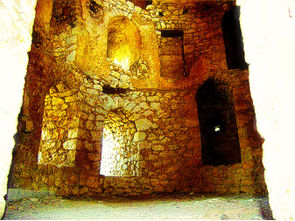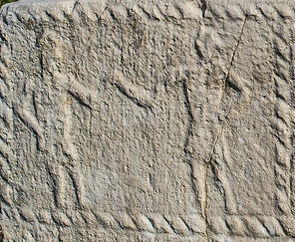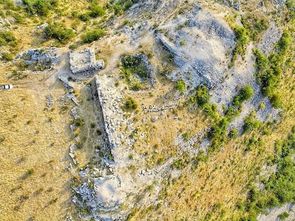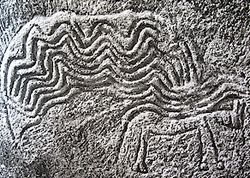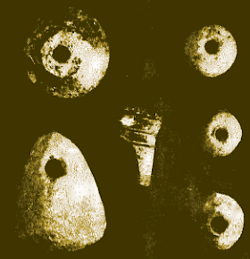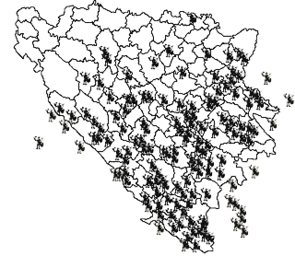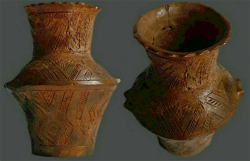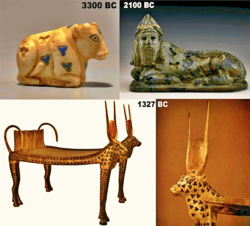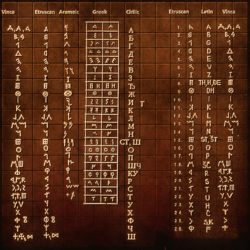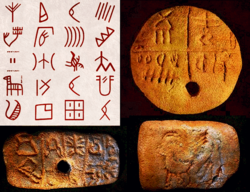
● KRIPTO-JEVREJI - manjina od 0,2% koja vlada Balkanom u aparthejdu ● CRYPTO-JEWS - a 0.2% minority which rules the Balkans in the last apartheid
Stecak
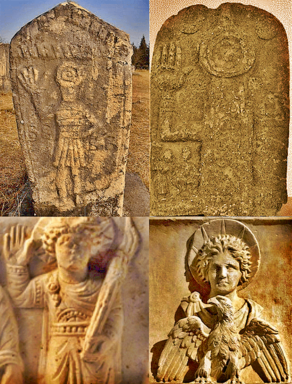
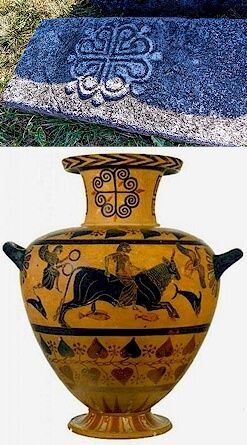


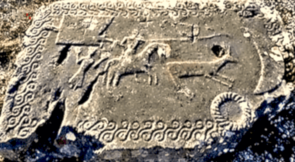
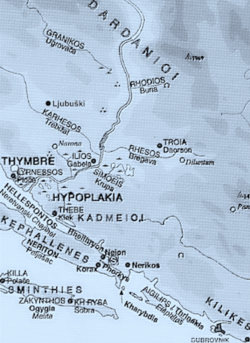
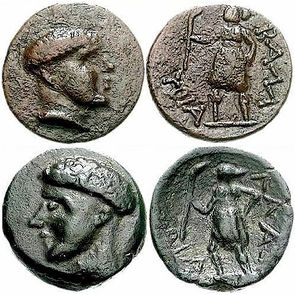
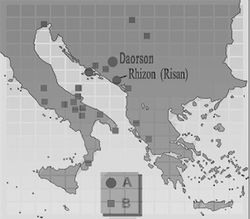
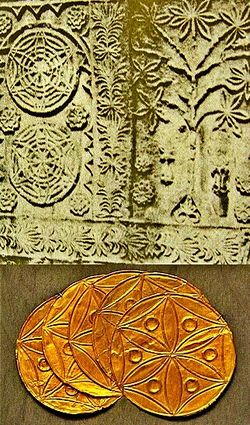
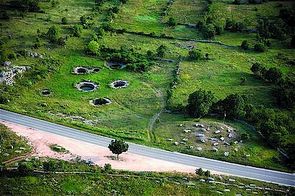
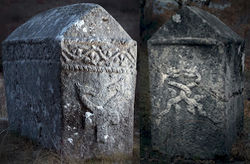
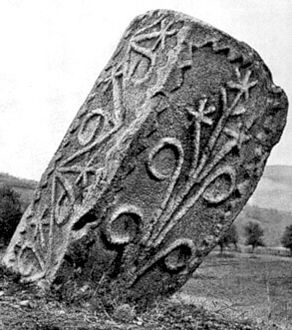
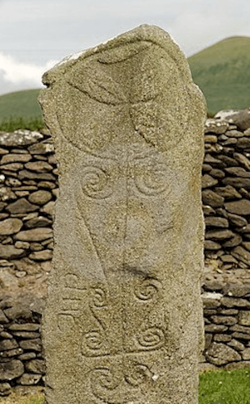
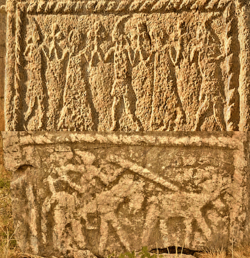
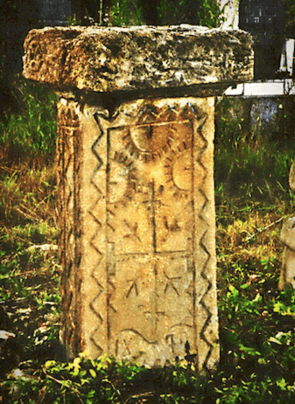
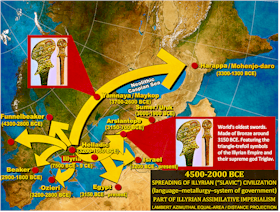
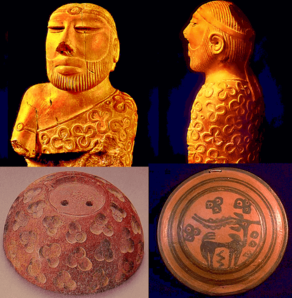
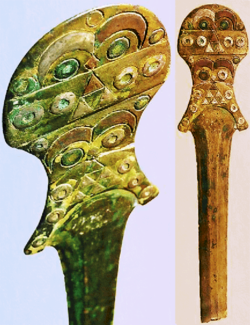
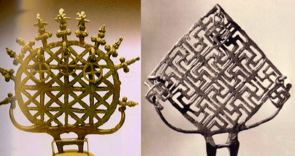
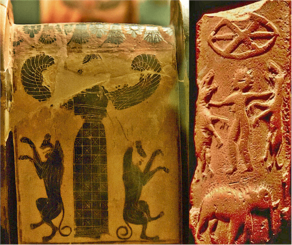
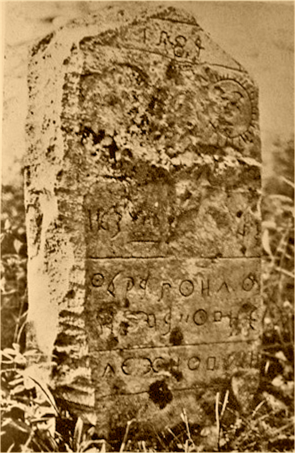
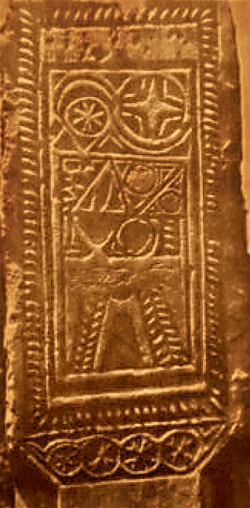
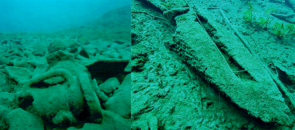
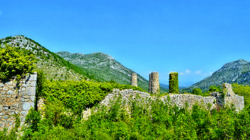
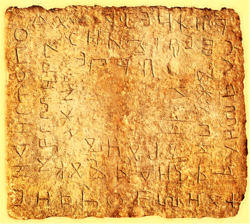
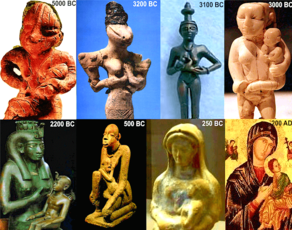
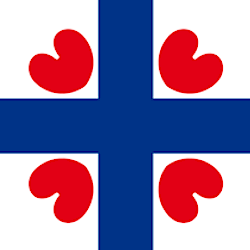
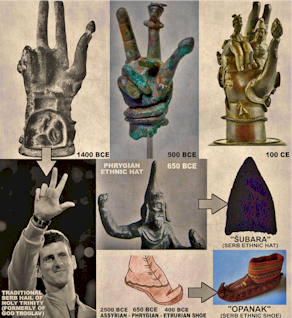
Stećak (pronounced steh-chuck), plural: stećci (pronounced stehtch-tzi), is a ritual stone slab of Old Bosnian civilization (pre-Illyrian-to-Illyrian) that — as seen from the world's first metal production (lead and bronze) between Tuzla in Bosnia and Pločnik in Serbia[12] — peaked around 4000-2000 BCE, which undoubtedly makes it the cradle of all civilizations and thus the forerunner to Ancient Greek civilization and Ancient Rome too. Stećci are found mainly in Bosnia (Illyria Proper[9]), and to a smaller extent in Serbia as well as along the seacoast (historic Bosnia; Bosnia Proper). The indigenous population from various cultures of the Bosnian civilization have painted with petroglyphs and engravings just around 2% of all the stećci. Many stećci got destroyed or damaged so that, of the total of estimated 250,000 pieces, about 100,000 survive until this day, which makes Old Bosnian stećci the largest concentration of stela dolmens (prehistoric burial blocks) in the world.
They feature motifs that reach in Prehistory (hunting or taming of wild animals; extinguished species; astral symbolism) and Antiquity (pre-Antiquity and Antiquity warriors with helmet plumes; mythological motifs; calendars). Some stećci contain carvings or inscriptions, of which a number is in an as yet unknown alphabet, while others include Illyrian (Vinčan) script, as well as glyphs, then Old Greek, Old Latin, Old Slavic (Glagolitic) and Bosnian Cyrillic (Bosančica). Stećci feature unique ornaments known in archaeology as the Bosnian style [10], elements of which can be found in Celtic, Gothic, Mediterranean, and Byzantine styles, and which got transposed also onto metal craft-work, jewelry, and weaponry.
Only a small fraction of stećci (between 300-400, or just 0.4%) feature medieval inscriptions[13], so it is incorrect to call stećci medieval monuments. Christian (mainly Catholic) motifs (crosses etc.) are found on only 0.5% of stećci, which means that stećci are not related to Christianity either but they precede it instead. Also, pre-Christian ornaments, motifs, and inscriptions by far outnumber Christian ones. Finally, medieval archives including the Franciscans Chronicles never mention stećci - neither the stonework nor engraving orders - while making no record of their existence at all. This unmasks selective approach of the Roman-Catholic Church that mocks people of the Old Bosnian civilization as "pogani" (cf. early Christians' slur Pagans for adherents of Old Bosnian polytheist religion, where pogan marks a lowlife in local languages as developed under Church's influence so to make locals regard their ancestors as lowlifes).
At the same time, Church destroys and arrogates Old Bosnia's monuments and customs - like supreme Illyrian ("Slavic") god Troglav (meaning: The 3-headed) - the highest deity of "Sky, Earth, and Underworld". Romans (Vatican) plagiarized this supreme Illyrian deity and incorporated it into their fake religion as a doctrine of Holy Trinity (therefore rejected by many Protestants): Sun - "Father", Earth - "Son", and Underworld - "Holy Spirit". Romans plagiarized Illyrian Sun-god Dazhbog (Dažbog) too, whose religion spread from Illyria into surrounding lands - in Old Rome as Sol Indiges, whose worshipers later on in the Roman Empire (1-3 century CE) formed what is regarded today as the "mysterious religion of Sun-god Mithra". This early Illyrian deity spread from Illyria into Syria as Sun-god Shamash, and also into prehistoric Egypt (6000-3100 BCE) as Amun Ra (that later on became Horus or just Ra), then throughout Celtic lands as Sun-god Belenus (3rd century CE), as well as into western China, India, etc.
Sadržaj
- 1 Prehistory
- 2 Antiquity
- 3 Non-existent medieval significance
- 4 Catholic Joint Criminal Enterprise ending in misuse of UNESCO
- 5 The cause of Vatican's/Rothschilds' hatred: non-existence of their right over Ilyria
- 6 The reason for Vatican's/Rothschilds' hatred: mythology as the excuse for aggression and crimes
- 7 Methods of Great-Jewish imperialism (via Great-Catholic and Great-Germanic expansionism)
- 8 Extermination of Illyrians ("Slavs") - end-goal of mad Italian and jew dangler oligarchs
- 9 Illyria is the cradle of all civilizations
- 10 How Yugoslavia Fell
- 11 Consequences of the Priority
- 12 Gallery
- 13 Related articles
- 14 References
Prehistory
The oldest archaeological find of the Old Bosnian civilization is the cave drawing of taming of horses, discovered in 1976 in Badanj Cave (Bregava canyon) near Borojevići in southern Bosnia. Archaeologists have identified more than 20 layers from prehistory and dated the site to Upper Paleolithic (Stone Age) (50,000-10,000 BCE). Primitive style and the fact that it is the only cave drawing on the east coast of Adriatic Sea mean that the drawing is one of the oldest examples of cave art of Europe made 35,000-45,000 years ago, or before humans settled in Western Europe. The drawing belongs in a widely spread cult of Europe's first settlers as they arrived (c. 45,000 BCE). The cave drawings were normally created as a prayer to gods via ritual depictions during winter months for a rich game the upcoming spring. The oldest paleolithic human remains in Bosnia, those of a Neanderthal dated at 40,000 BCE, were found in 1991 in Podlipa Cave near Sokolac in central Bosnia, along with rock carvings.
Within Bosnian civilization, the wondrous Butmir culture (5200 BCE)[1] near Sarajevo reveals artistic genius as a crucial characteristic of any civilization. Since the Butmir culture is the oldest artistic culture, and also the nucleus of the Old Bosnian civilization[2], the Old Bosnian civilization was the first civilization in history. As a more primitive form of creativity and expression, most of stećci are older than the Butmir culture, i.e., they precede it by 1000-5000 years. And while Butmir is the oldest artistic culture, proof that it, in fact, represents a civilization lies also in the fact that it encompasses to it adjacent Kakanj culture (6230 BCE) which is now known to be the Bosnian civilization's oldest - before the Starčevo culture (6200 BCE) and Vinča culture (5700 BCE) that were believed to be the oldest until recently.
Bosnian medieval cities developed largely from autochthonous fortifications from earlier periods, so for example, during archaeological excavations at the Royal city of Dobor, many remains from prehistory were found including abundant artifacts of Vučedol ceramics (Vučedol culture, 3000–2200 BCE), weights, etc.[4] Remains of a prehistoric fort made of mud bricks were also uncovered. There are seven layers in total, including those from Iron Age (2200-1000 BCE), as well as significant remains of Kostolac culture (3250-3000 BCE)[14]. Old settlements and forts from Neolithic (8000-2000 BCE) and Paleolithic (35,000-10,000 BCE) were also found at various locations throughout Bosnia. Excavations have shown that many medieval cities developed at places with prehistoric settlements. Most notable examples are medieval cities: Bobovac, Vranduk, Borač, Vratar, Sokolac (Sokograd) on Pliva, etc.[15]
Around 85,000 or over 85% of stećci are located in Bosnia, while the rest is in Serbia, Montenegro, and Croatia. Some locations show astrocentric component as the forerunner of later similar monuments such as the Stonehenge in England. More than 70,000 stećci are of casket or horizontal stelae shape. Since stećci are most commonly found at ritual burial sites - necropoleis - dating back to Paleolithic (35,000-10,000 BCE), Neolithic (10,000-6500 BCE), Eneolithic (Copper Age) and to it overlapping Bronze Age (together: 6500-2200 BCE) via Iron Age (2200—1000 BCE) to Antiquity, stećci as such are the proof of continuity of burial rites and thus the Old Bosnian civilization as well, consisted of various cultures.
Thus, Copper Age (the world's oldest find is in near Prokuplje in Serbia, dated to 6,000-5,500 BCE) and Bronze Age (the world's oldest find is on Rudnik mountain in Serbia - meaning Mt. Mine - dated to 5,000 BCE) have in fact begun in Illyria - which is a testimony to the Illyrian ingenuity. For the past few centuries to say the least, western European centers of power are having nightmares over those data, which prompted them to start inventing broader and broader definitions of a civilization so that their (more recent) settlers could be considered civilizations as well. One such utterly ridiculous definition claims that "a Bronze Age civilization is characterized by manufacturing or at least trading in bronze", into which they then count amber (fossilized tree resin picked at beaches along northern seas and used for making fake jewelry) trade routes to Illyria. But as amber cutting has been known since the Stone Age, they use amber trade routes as a "proof" their ancient "civilizations" are older than the Illyrian, thus minimizing crucial importance of ingenuity of the Illyrians for real advancement of the mankind. Namely, it was copper that marked the beginning of the Metal Age - the man's climb towards civilization as metallurgy spread from Illyria in all directions, thus creating the nuclei of fundamental cultures such as Russia, India, Israel, Egypt, Greece, Rome, Mesopotamia, Persia, and so on.
Antiquity
Bosnia is Illyria Proper (Uža Ilirija), and its people have neither Romanized nor Hellenized[9]. Instead, Old Greek civilization and Old Rome developed under Illyria's influence, which they later colonized: Greeks in Trojan war, followed by Romans in 9 CE, and finally the Vatican/Jewish elite as the Rome's new mask in Middle Ages all the way until the modern era. As a permanent target of its neighbors, Bosnia's (Illyria's) history has been subject to censorship, so that its most powerful kings are not mentioned in Roman chronicles at all (like King Balaj who minted so much of his own money that it can still be found on both sides of Adriatic so the Romans did know of him). On the other hand, Roman chronicles do call Illyrians the "barbarians", the "servants", and the "pirates" although Illyrians merely secured their own sea with their own fleet - namely, prior to Romans renaming Adriatic after Emperor Hadrian (Mare Hadrianum), it was known as the Illyrian Sea (Mare Illyricum). As mentioned, even today the Roman-Catholic Church calls Illyrians and all cultures of Old Bosnian civilization the "pogani" (Pagans; lowlifes, scumbags in local languages shaped under Church's influence).
Anthropological studies have also established that, contrary to Roman-Germanic expansionist mythology, the Illyrian anthropological type cannot be described as short and dark complexion like Albanians. On the other hand, documents show that, as Pannonians, Illyrians themselves were "tall and strong, always ready to fight and facing danger, but slow-witted"[9] (the last attribute is obviously ascribed from the standpoint of Roman imperial historians who equated well-intentioned Illyrians with being unruly and stupid, as a way of denying that Illyria was a civilization and not just a place inhabited with barbarians). Besides, life in the Illyrian lands has always been difficult, while countless defense wars against attackers are a testimony to how enduring the Illyrians have been.[9]
Obviously, with such a fighting spirit as the main characteristic of a civilization, Illyrians never got Slavicized either, giving credence to a Russian historical school according to which it was the Russians ("Slavs" in western sources: Latin for servants, slaves) who spread into Russian lands from Illyria instead of vice-versa as imputed mainly by western European sources. Inhabitants of Illyrian lands today are not newcomers - which modern research in genetic anthropology proved as well - but mostly descendants of ancient people of Old Bosnian civilization.
Troy
A stećak near Ljubuški (pictured left) depicts a calendar motif via mythological scene marking the Trojan war (1200 BCE), with princess Iphigenia in golden carriage observing her father King Agamemnon as he kills the holy deer in a field entirely enveloped in a braiding of thunder (war) in the astronomically described era of Trojan war. Ljubuški is situated at the outskirts of Trojan war theater according to Mexican archaeologist Roberto Salinas[3], so the stećak is a proof that Troy is in southern Bosnia (Hercegovina), which was a Greek colony during Antiquity so that archaeological findings with Old Greek inscriptions are common. Numerous locations of stećci are even today commonly called Greek cemetery. Other traditional names for Old Bosnian necropoleis include Divsko groblje (giants' cemetery), Grebnice (gravestones), Mramori (marble stones), etc. Mythological motifs were merely a method for depicting history lapidarily ("in stone") using metaphors; however, Trojan war was simply an aggression in which Greece colonized Illyria for the first time.
Besides, "Troy" in Turkey - allegedly unveiled by a rich idler Schliemann - fits neither material facts (the site's perimeter is miniature, cultures younger than Troy were found underneath the "Troy", etc.), nor historic tradition. Thus, in Homer's famous Iliad (which either means Illyria - or it is history's most incredible coincidence ever) Troy cannot be seen from sea while "Troy" in Turkey can (but inland Hercegovina can not); Troy is in a Land of snow like inland Bosnia and unlike coastal Turkey; Illyrian symbol is a cloverleaf (shamrock) which is seen on stećci depicting Illyrians dancing the Trojan dance while holding a 3-leafed clover (Trefoil) as a sign of Illyrian god Troglav (Three-headed); one of the three Trojan tribes in Iliad (Phrygi or Bryges, or Brigi - highlanders in local languages) wear Phrygian (Brigian) caps (today symbol of liberty worldwide, like in the Coat of Arms of US Senate) while the Illyrians depicted on stećci dancing the Trojan dance are wearing Phrygian cap; Trojans mostly drank medovina (honey wine) - while Turks later renamed Illyria into the Balkans (Turkish: "Land of honey and blood"), as upon invading Bosnia they found it to be a traditional honey-harvesting country with hives in every village; this prompted the Sultan's grandson Husrev-bey - after executing the Bosnia's last sovereign Prince Berislavić in 1535, to take possession of the Prince's royal estates too while including "hundreds of Prince's hives into his own endowment", and so on.
Also, etymology of Troja (En. Troy) - cf. troina (trinity) due to the supreme Illyrian deity Troglav, reveals that Trojanci (Trojans) was in fact one of the names the Illyrians used for themselves, in addition to Panini (Pannonians) and Serbi (Serbs). This people can nowadays be regarded as proto-Slavs or simply "Slavs" proper (the "Slavs").
Non-existent medieval significance
Less than 1% of all stećci are or could be related to Christianity or Middle Ages. In medieval archives, including the Franciscans Chronicles, there is no mention of work orders - either for making or engraving of stećci. Therefore, as in older cultures of Old Bosnian civilization, people of note in Middle Ages used to hire stone cutters only sporadically to inscribe stećci for the customer's prestige. Human remains which date back to Middle Ages and Antiquity have been found under just a few slabs. This means that those rare stećci were merely moved so that deceased could be placed underneath. Obviously, there was no industry of stećci making in Middle Ages.
Most stećci are too massive for moving with everyday means of the era such as livestock tandems, which is one of the main reasons why "medieval stećci" (the ones inscribed during Middle Ages) are so rare. Most stećci cannot be moved even today using usual technology. The most massive known (above the ground) stećak is in Pavlovac near Sarajevo, with the mass of around 32 t.
Catholic Joint Criminal Enterprise ending in misuse of UNESCO
Sadly, of more than 70,000 known stećci at over 3,000 locations, UNESCO in 2016 declared as World Heritage monuments less than 4000 ("a selection of 4000") at just 28 locations, shamelessly openly picking exclusively the samples that are or could be related to Christianity (Catholicism mainly). That is a horrible misuse of science and UN funds in the geopolitical interest of the Vatican/Jewish elite and permanent criminal role of popes in Bosnia who by this move, same as other manipulations are trying to prove the non-existent historic right of popes over Bosnia. Vatican rents Bosnia to foreign powers since Roman occupation of 9 CE.
In addition to always Catholic governors (called "High Representatives" but with absolutist powers of viceroy) in Bosnia, the apartheid by Catholic minority over non-Catholic majority, as well as UNESCO's protection of primarily (allegedly) Catholic necropoleis, a proof that the Vatican (today Crypto-Jews in the Balkans) is usurping the sovereignty right over Bosnia lies in an ad hoc "Commission to preserve national monuments of Bosnia and Herzegovina" (note double meaning in the title as English is the only official language of Dayton Accords), which declares just some necropoleis as monuments, where in fact the (sovereign) state ought to name (declare) all 60,000 stećci as a national monument altogether. For instance, the English turned a single Stonehenge into world sensation, while quisling authorities treat 3000 Bosnian "Stonehenges" like trash.
The relationship towards cultural monuments is a proof that Bosnia is an undeclared protectorate (colony) - where the purpose of the fake Commission is to create an illusion that sovereignty usurpation is legal (the care for national goods). Western powers behave in Bosnia same as Taliban in Afghanistan while destroying or enabling the destruction of monuments belonging to ancient civilizations and cultures.
Declaring some stećci - dating back to times before Egyptian pyramids - as Catholic because someone inscribed on them a trace of existence is the same type of crime as declaring an Egyptian pyramid Catholic just because some tourist inscribed his/her name and signature on that pyramid. This misuse of UNESCO is an act of indirect forced Christianization, banned under international law. It is culmination of Great-Catholic Joint Criminal Enterprise enabled by bloody split of Yugoslavia with help of neofascist NATO pact to advance the borders of Catholic sphere of interest towards the Drina via the Total war method including a decades-long exhaustion of non-Catholic population.
The cause of Vatican's/Rothschilds' hatred: non-existence of their right over Ilyria
All unresolved questions about and around the country of Bosnia from 1527 until today boil down to just one and purely legal question: who will control our resources. Answer: Bosnian resources can legally be controlled exclusively by the majority ethnic groups(s), based on the historical right over Bosnia which belongs to those who have the oldest right in it (eng. the right from time immemorial), as determined by the scientifically dated age of civilizations and cultures in a certain area. In the case of Bosnia, these are, according to age and cross-distribution in the area of today's Bosnia and Serbia, and according to reliable scientific sources (from the oldest to the youngest):
- (1) Kakanj culture - 6230 BC,
- (2) Starčevo culture - 6200 BC,
- (3) Vinča culture - 5700 BC,
- (4) Butmir culture - 5200 BC,
while the oldest civilization in the world according to the criterion of the beginning of civilized, i.e. metallurgical age-copper is:
- (5) the culture along the stretch of Tuzla in Bosnia - Pločnik in Serbia - ca. 4500 BC.
Also, the oldest European culture overall is Lepenski Vir, which is known for sure to have started in 7200 BC, and maybe even earlier, but it is only found in Serbia, so it cannot be included here. Therefore, a permanent deed to the land of Bosnia ("the internal sovereignty right"), i.e., the right to have their own independent order/regime on the land of Bosnia in our time belongs exclusively to today's Bosniaks and Serbs because they, by a large majority, which is an undisputed absolute (mathematical) majority at the level of the country, continuously inhabit the areas of the mentioned cultures and for neither of them (and therefore not for Bosnians as a whole) are there any reliable (coming from multiple primary independent sources of verifiable data) information that they came from somewhere (anywhere). Based on these scientifically established facts, it is clear that the great-catholic and great-jewish expansionism and their crypto-jewish quislings do not have any rights over Bosnia or in Bosnia, and especially not to regulate its order and call it as they pleased, such as "Bosnia and Herzegovina".
Thus, the Bosnian Croats are a minority that will remain in that status (1) for as long as Bosniaks and Serbs are minorities in Croatia and (2) for as long as the Croatian minority fails to present historical and legal legitimation of having internal sovereignty. This legitimation can only be in the form of scientific evidence that in the lime lands of South Bosnia (i.e. in the so-called Herzegovina), where that minority lives for the most part (allegedly as the most cultured - and even more cultured than the majority peoples that they unjustly rule over in apartheid on the basis of culture), a culture was found older than the cultures of the most numerous peoples of Bosnia - the Kakanj and Starčevo cultures. Until then, it is considered that the majority of Bosnian Croats were dragged to the said lime lands by the Roman legions (which is no longer a secret and today is well known to leading Western historians), i.e. that they are a recent phenomenon in/addition to the country and a relic of Rome's aggression against Illyria. So, in order to be entitled to a "seat at the table", that minority must provide scientific evidence that they are older (more cultured) than the majority.
The reason for Vatican's/Rothschilds' hatred: mythology as the excuse for aggression and crimes
The cause of Vatican's (Jewish elite's) hatred of Bosnia (Illyria) lies in an ancient fundamental belief (which, at the Vatican's horror, became the foundation of Protestantism), according to which Illyria is the First historic kingdom of the total of four historic kingdoms (primordial civilizations) as predicted in the oldest known prophecy (Book of Daniel, 160 BCE) will appear on Earth. "Romans" (Vatican) advocates among philosophers (theosophists) the idea that those four kingdoms were: Babylon (1700-550 BCE), Persia (550-350 BCE), Greece (1200 BCE - 600), and Rome (700 BCE - 450) - meaning all history ends with Rome (Vatican) as "permanent ruler of the World" destined to lead Earthlings into the Space Age. However, Old Bosnian stećci are the counter-proof of that, and a testimony to Illyria having been the first historic kingdom (with Greece then as the fourth) so that Rome (Vatican as the best-ever investment of Jewish elite ever since they literally purchased Rome in 1605) not only has no historic right to rule the World but they are also an extra and a history's error.
As a backup plan (if obtrusion of Catholicism fails), the "Romans" (Vatican/Jewish elite) are trying to take over the role of fourth historic kingdom with help of Germanic peoples (Germans, Austrians, etc.) as a proxy where Catholics as the Jewish elite's most numerous cannon fodder are the largest religious group (and thus have a shaping impact on geopolitics of those lands). The end goal of the backup plan is to subdue the World via the Germanic system of values "until the end of time" (for all eternity). Bosnia (Illyria) does not fit in the Vatican's/Jewish elite's backup plan either, given that German Protestants in the 19th century already chose Egypt (3100-30 BCE) alongside Babylon, Persia, and Greece, in their own fight for liberty so to mitigate the "Roman" (Vatican's/Jewish elite's) influence. So Bosnia (Illyria) as the First historic kingdom is an obstacle in that backup plan too.
The Vatican conceived the Great Schism of 1054 (division of Christianity) through the middle of Illyria, and design of fake Illyrian peoples (tribes) from one people as a tactics for erasing Illyria from history - as noticed by the world-leading expert on Illyrians John Wilkes who, while placing Illyria in Bosnia mainland (Illyria Proper), states that "Illyrians fill only the margins in history books"[9]. Bosnia (Illyria) has thus found herself in the middle of fight between foreign geopolitical interests for global domination via misuse of ancient mythology.
Methods of Great-Jewish imperialism (via Great-Catholic and Great-Germanic expansionism)
As a fundamental proof that Bosnia is the cradle of Western and all other civilizations (meaning Ancient Greek civilization and Ancient Rome were/are not), the question of stećci is subject to manipulation under external influences that try to limit the stećci to merely medieval era and significance. Thus Bosnians (Illyrian peoples) are a victim of attempts to take away their historic right over their own domicile from before Christianity, meaning before Roman law spread to Bosnia with establishing of the Banate under Prince Borić[16].
As part of official yet largely fantasized history, as imputed mainly by Germanic (Austrian) geostrategists and the Vatican/Jewish elite and their local quislings and Crypto-Jews since the Berlin Congress of 1878, are:
- a myth of the Great Slavic move who moved into Illyria while brave Illyrians, whom Rome could not subdue for centuries, literally evaporated or at least withdrew terrified of allegedly nomadic Slavs without a trace of the Big War at that (except for usual mentions of sporadic fighting and mutinies like elsewhere in Europe). The facts that there was no Invasion war and that after 9 A.D. Romans called Illyrians only those loyal locals (who paid taxes or joined Auxilia legions) while freedom-loving patriotic Illyrians who would more and more rise against Roman oppression (and finally liberate the land) were demeaned as "Slavs" (Latin for slaves, servants), show that the whole myth is baseless, unless one takes Roman/Vatican sources (filled with geostrategic minimization of Illyria such as the ignoring of her most powerful kings) seriously - which only an unethical scientist can do. Eastern sources, Bulgarian in particular, proved to be nothing less biased - even taking meaningless descriptions uncritically, i.e., as facts, for example: that according to (unverifiable) Byzantine sources "Slavs were so numerous that grass would not regrow where the Slavs had marched through"[17]. Nevertheless, leading "Byzantologists" (historians who study the history of countries that succeeded the Eastern Roman Empire), describe a "Slav invasion from the northeast into Bulgaria all the way to Serbia" which then proceeded "westward via the Pannonian plateau (Hungary) and along the coast of Adriatic Sea"[18], but not into Illyria itself, i.e., Bosnia and Serbia. Namely, it is only logical that the topography of Illyria, which had prevented the Roman Empire and later on Catholicism from spreading from the west, had also prevented any spreading of tribes from the east as well including the tribes those historians called "Slavs" while never placing those tribes inside Illyria.
- a hoax of relocating Troy from Bosnia to Turkey with help of pseudoscience of "pick and shovel where rich idler Schliemann decides", etc.
They all have the same goal: to deny local peoples (a single and unique people, in fact) their historic right to a specific geographic domicile. The means for achieving that goal include the aggressive Great-Catholic expansionism (Great-Jewish, reflecting the new owners of Catholic Church) and its proxy the Great-Germanic expansionism towards warm seas - as conceptualized by Otto von Bismarck and pronounced over the past century and a half, resulting in two World Wars. Thus, having lost both WW1 fought with brute force and WW2 fought with a combination of force and quislings, the Vatican and Berlin (meaning: Jewish elite and their Crypto-Jewish quislings) - upon finding out they are unable to conquer America and Russia by force - now attempted a soft WW3 with quislings only - so-called globalists with fake agendas like climate change, pitting America against Russia, and deindustrialization - all aimed at strategically weakening the Protestant America as the main obstacle to pope's (who in fact is an absolutist king but Jewish since 1605) totalitarian rule over the Earth - a digitized version of the Dark Ages. And that is where projects like Wikipedia come into play - as the Vatican/Jewish elite quickly adapted itself in the spirit of the Information Age: "He who controls information - controls the World!".
Using diplomacy and the EU as a proxy, Bismarck's followers (who were empowered by the Vatican II where German Jesuits/Jewish elite tightened the grip over the Roman-Catholic Church), have tried to create a loophole for bypassing the rules of the international order, namely the terms of their preceding capitulation that forbade territorial expansion. Other methods German geostrategists use for softening of resistance to their Bismarckianism include selling of German pseudophilosophy as though the pinnacle of all knowledge, via Teutophile (therefore fake) philosophers in target-nations. Other methods include unnecessarily equating of fascism and communism - though the former was the means of Great-Germanic territorial expansionism which is going on still today (monetary war and economic terrorism, instead of gunpowder). The latter on the other hand, was a means of heroic resistance to pseudocapitalism into which German and Austrian elites wrapped themselves at the turn of 20th century and who, ever since, pose as respectable industrialists and financiers, such as Hapsburg family with its Grawe Insurance, Raiffeisen Bank, etc. At the same time they took their Bismarkianism to the full swing; with their original attempt having nearly collapsed in a great economic depression, they dropped the mask of German civility and marched during the 1930s right into a series of bloody aggression campaigns. It was not European nations who marched first to conquer Germany; it was the Germans who wanted to conquer other nations first. This makes it obvious that there is nothing to forgive: who forgives for having defended themselves - and does so in order to ease the enemy's consciousnesses for attacking again?
As for the often-heard claim by Germans and their quislings, on the Germans' alleged historic right to rule Europe as pursuant to a numbers argument ("We Germans are the biggest and the most powerful, therefore we should run Europe"): You do not get to decimate Europe over ten generations - murdering and displacing half of its population - and then come back in the eleventh generation to lay claim to that same Europe based on your numbers, be it demographic or macroeconomic - same thing when it comes to Germany! Despite the wishful thinking of German geostrategists, you just do not get to do that, as you have surrendered all of your historic rights in the process, not just by the act of signing the 1945 capitulation, but primarily by inflicting the most heinous acts upon Europe ever.
In their aspirations, not even the extraterritorial (fake) Tribunal in Hague is of use, despite it very often performing the same role for the followers of expansionist Bismarckianism in South-East Europe as the Hitler's fake courts previously. Concerning special warfare methods in Bosnia proper, the Church and the Hapsburgs (who nowadays control crime clans along the Orient geopolitical stretch Vienna-Skopje) always saw Bosnian Muslims as nothing more than useful idiots for destroying Serbs (e.g. the 1990s inciting of the Muslims under the Kotromanićs' fake coat of arms) since Catholics in Bosnia are too few to carry out such a mass crime, and the Vatican (Jewish elite since 1605) - as always in the last 1000 years - would fight Serbs until the last Bosniak/Muslim.
Methodology for hiding the truth about stećak and Illyria
Methodology for hiding the truth about stećak and Bosnia has many layers, and includes:
- direct destruction, often by using stećci as a building material in erecting large objects such as churches (including Orthodox), by staging construction digs under the excuse of expansion of Catholic cemeteries, by building roads (even low-rank ones, whose route is easy to adjust) through best-preserved and most beautiful necropoleis such as Radimlja, Rostovo (Novi Travnik) etc. by Catholic Austria-Hungary in the past, and Crljivica by Catholic Croatia today, by stealing artifacts and documentation from archaeological locations like underwater site of Illyrian fleet of the oldest ships in the World at Hutovo blato and taking them to Croatia[11], by stealing the Bosnian royal jewels and other valuables and taking them to Croatia, etc. (The Vatican has a long history of enmity towards Bosnia, long before Jewish elite took control of the Church in 1605: not too long after the arrival of Catholicism to Bosnia in 1070, the Vatican already in 1252 – running from the locals enraged by Catholic clergy systematically destroying ancient Old Bosnian stećci - moves the Bosnian Diocese from Sarajevo (Vrhbosna) to Đakovo in today's Croatia.)
- direct negation that stećci have anything to do with Antiquity and earlier periods, e.g., by a "communist" pseudo-historian Šefik Bešlagić (his real, that is, Crypto-Jewish name was Schefrig Beschläger) who in his idolized works openly berated everyone who pointed at evidence that stećci are not medieval monuments,
- selective glorification of the statistically negligible sample of those rare stećci which, by adding inscriptions, became superficially related to Christianity - as though the only or at least a majority of stećci,
- promoting of mythomania such as on Bogomils' Bosnia,
- inserting agents-confusers like one wordsmith Catholic priest Goran Šarić (who regularly visits this site to literally copy everything he reads on it), who then publicly claim the same things as the Vatican's/Jewish elite's archenemies claim - thus attempting to minimize the enemy's credibility within his/her own grassroots. Namely, such a simplest strategy that the Vatican has merely copied from the Romans, achieves two important effects: (1) the Vatican's/Jewish elite's archenemy becomes obvious traitor to his own surroundings over promoting the same ideas that the Vatican too "promotes" (via its agent who himself first discloses that he works for the Church - nowadays meaning the Jewish elite primarily), and (2) the Vatican's subjects and Jewish owners/creditors alike become even greater admirers of the pope over his ability to insert his agent such as Šarić behind the archenemy's lines. Namely, Roman senators had noticed long ago that there are two conditions for conquering a people: (A) taking its religion away (and replacing it with something - anything really, including controlled atheism, ecumenism, etc.), and (B) making the targeted people get rid of its own leaders. As the central instrument of the Vatican's geostrategy of conquest, the Church has rebranded its tactics for achieving of the above Vatican's geostrategy based on the following adage: Wordsmithery is the shortest road to one's heart and soul!, or: Words are free!.
It is worth noting that an agent-confuser is usually planted as "Plan B" - after the Church fails portraying (to her followers and creditors) the archenemy as the Church's own agent as done for the same 2 reasons as for the agent-confuser: (1) to make the archenemy's surroundings reject the archenemy as pope's "obvious spy", and (2) to strengthen trust of followers and creditors in the Church once able to plant her own top agent behind enemy's lines.
The inversion of the truth about Bosnia is most obvious in the case of stećci, but it is present, although in covert forms, in practically all branches of (manipulations-prone) historical sciences. For example, German Nazis claimed Old Germanic motifs on Bosnian stećci, such as Swastika, although those were just traces of ancient Illyrian cultures older than Germanic (for example, rock art depicting Swastikas from the Neolithic on the Scripted rock near Višegrad[2]). Similarly, although ancient legends represent an Illyrian as an Eponymous Hero of the "mythical serpentine people of Illyrians who were neighbors of the Enhelians - the eels people" and Illurjanka was Hittite for a mythical snake[5], those stećci which contained motifs inscribed by the Illyrians themselves or motifs added later on by followers of the Gothic cult of Germanic God of snakes (655-990), were amateurishly interpreted within the UNESCO nomination (and designation as a national monument) as a "depiction of dragons from the 12th century."
Extermination of Illyrians ("Slavs") - end-goal of mad Italian and jew dangler oligarchs
In ancient times some 3000 years ago, after realizing the power of religion in Etrurians i.e. Illyrians as the primordial adventists of statehood and spirituality on Earth, con artists among Italian oligarchs, nowadays in a pact they formed with the Great-Jewish elite (the so-called Judeo-Christianity - neither Judaism nor Christianity!), plagiarized religiousness from Illyrians and turned it into a cheap concept-trick for fabulous enrichment of dangler Mediterranean i.e. Italian oligarchy: first via Ancient Rome as a depraved variant of the original Illyrian enlightenment imperialism, and then via the Vatican (goes on still today when the Church is under the Jewish popes since 1605). The Rome, as well as the Vatican/jewish elite later on, attempted to literally wipe out the Illyrians ("Slavs") as the undesired witnesses of the Italian (now Jewish) con art with Catholicism - the history's biggest con art ever. In more recent times, the attempt took the form of ever more destructive wars - campaigns of Bonaparte, Hitler, and today NATO - for the extermination of Russians as the largest Illyrian people today. Besides Russians, other branches of the Illyrians i.e. those who spread the civilization northward and southward, have been exposed to the same type of treatment by the Vatican/Jewish elite and governments of nations in which Catholics and other papists (Crypto-Jews and Vatican's loyalists regardless of faith - for money, under blackmail, etc.) run key ministries (usually of: military, finance, security, etc.).
Catholicism is merely a Roman oligarchy's tool for global looting: the Italian mafia - Global Edition. And so it uses the same methodology too: while offering trickery and "protection" (from itself!), mafia acts locally. On the other hand, the Catholic Church tries to conquer entire nations and peoples by also using trickery and "protection" (from itself i.e. "great powers" where the Church controls the so-called imperial ministries: of "defense" = war, of "finance" = taxes, of "foreign affairs" = quisling/agent network!).
For example, one of the best-kept secrets of Western Europe is the constant oppression of an ancient people of Frisians - the branch of Illyrians (Brigi or Highlanders) who during the spread of Illyrians northward became the core of proto-Nordic and proto-Germanic statehood. Today, under the influence of the Vatican, Western Europeans (meaning: papists and Crypto-Jews within governments there) have been attempting to prevent unification and independence of Frisia - now an EU region with some 3 million people with a developed self-awareness of their ancient being. Thus Frisia today is deceitfully split among Western-European countries into four parts (Narrow East Frisia, Wide East Frisia, North Frisia, West Frisia) - which is a signature of the Vatican's geopolitics (a symbolic "crucifixion of targeted people on the cross") - in the same way in which Illyrians are split nowadays also, into four peoples: Bosnians/Bosniaks, Montenegrins, Croats, in addition to Serbs. The branch of Illyrians that had spread the civilization southwards into Mesopotamia and Sumer - the Kurds, and their Kurdistan, are also split into four parts (Northern Kurdistan - Turkey, Southern Kurdistan - Iraq, Eastern Kurdistan - Iran, Western Kurdistan - Syria). Kurds are the most authentic living proof of Illyrian enlightenment imperialism: named after the Kurus (meaning: rooster) dynasty from which they descend (the world's primordial dynasty, according to the Indian Mahabharata epic), the Kurds kept rooster as their national symbol until this day.
That the Frisians indeed originate from Bosnia is readily seen from their language which conserved Old-Bosnian (Illyrian) words, e.g. etymology of the very word Bosnia (Bosna in Bosnian) is from the Frisian Bosma for highlanders, people from/of the forest[19]. The most heinous treatment of Frisians today (according to their current Movement for United and independent Frisia Groep fan Auwerk) is by German government which is trying to assimilate i.e. Germanize the Frisians in all ways possible, and thus destroy identity and awareness of this people's ancient history. The Frisian coat of arms is a stylized symbol of ancient Illyria (picture) with a motif of old Illyrian symbols - four ram horns, or in Nordic legend: the four leaves of water lily although ancient Scandinavia was not a wetland, unlike Illyria back then as well as today (e.g. Hercegovina with its Hutovo marsh featuring an archaeological find of Illyrian sea fleet of the oldest ships in the World older than the Kufu ship by 500 years (all while animal feeders and canoes are being presented to the public as the oldest ships in the world) along with proofs from early Bronze Age). Thus the ancient Frisian coat of arms is basically a means for preserving the truth about that people's origins via a truly immemorial tradition. Namely, the Illyrian coat of arms got into the Frisian coat of arms by way of Nordic rock art where the symbol can be found along with Swastikas; it is the same as the Serb ancient and contemporary coat of arms. Pre-Antiquity and early-Antiquity reports on Frisians are extremely sparse (same as with Illyrians, as the Vatican tries to wipe them all out from history regardless what part of the world they can be found in nowadays). And just like with the Illyrians, it has been documented that Frisians too had never waged wars of aggression, and were the bravest proto-Germanic tribe that Romans never managed to subdue - in spite of horrific massacres of civilians by Romans decimating Frisians to the present-day numbers. That is the exact same destiny that befell upon all Illyrian peoples of the World, nowadays subjected (by papists in various governments) to the most difficult pressures imaginable, all because they are undesired witnesses of the mad jew and Italian dangler oligarchy and its con of all cons.
As with all empires, the Vatican too operates along decennial-to-centennial time scales. The natural sluggishness of any imperialism makes it difficult to notice all of the aspects of a real (long-term) geostrategy of the Vatican too. This gives the Vatican an additional opportunity - alas along shorter time scales, from everyday-to-decennial - to act as though seemingly friendly or even well-intentioned. Thus, for example, the Vatican uses the fact it does not recognize Kosovo (independence of) for short-term ingratiating itself with Serbs - although the real reason behind the Vatican's not recognizing Kosovo lies in saving the integrity of Spain from a modern European precedent that could enable separation of Catalonia (Spain is to the pope what England is to the British monarch - the pillar of earthly geopolitics of hard-line control over half a billion Hispanics worldwide). In another example, the Vatican used to hire Frisians (known for their bravery and warrior skills) as the original papal Swiss Guard all the way through the end of 10th century and the beginning of the Great Schism (1054). Today, Frisians make one of the cores of Protestantism - the greatest and most noble mutiny against the Vatican ever.
On the other hand, in its real i.e. long-term geostrategy the Vatican and the Jewish elite via their proxies like Crypto-Jews and Masonry has tried during the past hundred years or so to regain supremacy lost in the 16th century when Elizabeth I sank the Spaniard fleet. As the result, Britain had gained supremacy over world seas and colonialism, and subsequently imperialism and industrial revolutions along with technological advancement as well - an advantage they preserve til this day. In a recent example, since there are too few Italians for global conquest nowadays, the popes used their agent Crypto-Jew Mussolini and German Catholics who practically supported the ideology of Bismarck, to suck Germany and a Crypto-Jew Hitler into a Great War, though as mere baits for hunting down the biggest game the Vatican has been targeting since the Antiquity - Russia, and another Crypto-Jew Stalin, in the geostrategy of extermination of Illyrians ("Slavs"). During all 3 World Wars (the 3rd one being fought since 9/11/2001 with quislings alone - the so-called globalists - after the failure of just brute force (WW1) and a combination of brute force and quislings (WW2)), the Vatican has achieved a demographic advantage by way of largest casualties befalling on "Slavs", Protestants, and Muslims. (Note that Hitler was not a cause by any stretch of imagination, but merely a symptom of the Great-Germanic expansionism, and one of the methods for achieving Great Germany, and who was succeeded in the modern era by one Kohl, Genscher, Merkel and the rest of Crypto-Jewish looters.) Using the Great Wars as a "corrective demographics method", the Vatican/Jewish elite thus each time increased the relative demographic advantage for Catholics as the prerequisite for economic and any other form of supremacy. If accumulated, such an advantage could create a momentum for controlling of the mankind and throwing humans in shackles of Dark Ages (this time around: a digital-technological version of). It is worth noting here that criticism of papal earthly politics cannot be understood as discrimination of Catholics, also given that they make around 55% or the majority of Christians, and every arguments-based criticism of behavior of a majority is always positive because the end-result is advancement and betterment of all instead of that majority only.
Given that during the past 2 millennia 140 empires on Earth had risen and fallen while only one globalist force with imperial pretensions was left - the Vatican, it is clear that the main business of the Vatican ("Rome" of today; nowadays under Jewish popes since 1605) is not merely creating of empires (by inserting its quislings into imperial ministries in Governments of targeted nations), but primarily empire recycling - therefore both creating and destroying of empires, all in order to maintain the geostrategic advantage of Italian oligarchy and its global interests. To that effect, the Jesuit order of the Catholic Church as pope's modern-day "Praetorian guard", thanks mostly to its experience across centuries of the dirty business, always have up their sleeve a ready-made lie - for everyone and for every occasion. In other words, the Vatican/Jewish elite and the Church use always the same (meaning: trusted and well-oiled) schematics by which they conduct their uber-imperialism - or as a Protestant diplomat warned the mankind of more than a century ago: "Those who do not learn from history are doomed to repeat it!".
In order to control Catholicism as the Italian oligarchy's mechanism for global dominance, the papacy must be dissolved. The Papacy is a religious anomaly, as religions do not have global leaders; besides, religion is a matter of private feelings and freedom of each individual. Even prior to modern times, Rome was prone to savagery as seen from their industrialization of slavery, so it can be argued that Italians understood modernism primarily as a method for perfecting of their long-term savagery - all while portraying it as a short-term civility i.e. civility with temporary interruptions for which papists allege are due to "violent nature of humans", "centennial conflicts", and other excuses for adding to the momentum of their long-term geostrategy of global dominance. Here it is important to know that the overall advancement of the mankind (science and technology, tripling of human longevity, and so on) is primarily a result of global resistance to the Vatican, and that the Vatican's (now Jewish elite's as the Church's owners) end-goal is, as always, to subdue humans and throw them in shackles of Dark-Ages type of totalitarianism as the only method of global rule comprehensible to Italians since Old Rome, so that it cannot be expected from them to ever accept (or even comprehend) another concept of global governance instead.
Illyria is the cradle of all civilizations
That Illyria is the cradle of all civilizations is seen from the comparative dating of a global characteristic sample of all the important features of an imperial expansion, in this case, expansion of the Illyrian ("Slavic") influence. It is clear from this comparison that not only worship of the supreme gods in many cultures around the world originated in Illyria, but the same also happened with worship of supreme deities (both male and female), then the legends (mythology), language of the elites, as well as metallurgy (Illyrians discovered production of copper and bronze, and probably iron too though that has been debated), along with everything else that an imperial expansion implies. Thus, the world’s oldest figurine of the goddess of fertility with a child in her arms (called kourotrophoi) was found in Vinča (5000 BCE), with the Phrygian (Brygian) cap on child’s head. The worship of this goddess expanded to Old Greece as the cult of goddess Demeter (later on goddess Artemis or Artemia, also known as Delia), in Africa as the goddess of fertility of the Djenné-Djenno (Niger basin) – the oldest culture of sub-Sahara, in Sumer as the Sun-goddess and fertility-goddess Innana, in Mesopotamia as the snake-goddess, in pre-dynastic Egypt as the fertility-goddess Isis (mother of the Sun-god Ra, or Horus), while the Romans plagiarized it as goddess Diana, and then the Vatican too as its concept of the Virgin. It should be noted here that, according to Old Egyptian tradition, it is the Brigi or Illyrian Highlanders who were the first people of the World, i.e., the primordial civilization.
Illyrian assimilative imperial expansion – the creation of Russian and Indian protocultures
In the Harappa culture, in Mohenjo-daro, India-Pakistan (3300-1300 BCE), which developed in the west part of the Indian subcontinent – indicating that it came from Europe –a relief was discovered depicting the Illyrian omni-goddess (sveboginja or sei-boina, i.e. Serbona in a possible transliteration by J.I. Deretić). On the relief, the goddess is seen taming wild beasts beneath the Illyrian symbol of the Sun-wheel ("eternity"), while underneath stands a mammoth she thus caught – dating the relief back to the eras before 2500 BCE (extinction of mammoths). This display places the Illyrian Empire in the period between the early days of Illyria (since the end of the Butmir and Vinča cultures) and the spread of the Illyrians to Asia at the peak of Illyria since its creation around 7500 BCE. This reveals the period of peak of the Illyrian Empire as 4000-2000 BCE, and the period of decline as 2000-1500 BCE, after which Illyria in Trojan War in 1200 BCE fell for the first time to Greece. Several centuries later, the Illyrians reestablished their state – the Kingdom of Illyrians – which the Greeks then re-conquered several times after that; however, any attempts to assimilate Illyrians remained unsuccessful. Subsequent empires took over the Illyrian concept of expansion of the zone of imperial influence (the imperialism) by assimilation, such as the Roman Empire, i.e. the Holy Roman Empire, then Spain, Great Britain, etc., but with enormous cruelty and sinister tricks like slavery, colonialism, quislings, and so on. On the other hand, the Illyrians never kept slaves, never exploited others for profit, nor did they have their own quislings elsewhere. The Illyrian imperialism was that of an enlightenment, and it has not been recorded that they or their descendants ever engaged in a war of aggression but always and only defensive wars, on their own territory. However, others always used fruits of creativity of the Illyrians and their descendants who in return would be faced with hatred and an original Italian “invention” – excommunication, as in case of Nikola Tesla and others.
In addition to the aforementioned characteristic (statistically significant) sample of always highest ranking both gods and goddesses that can be traced back in time all the way to Illyria, the language too was transmitted to other regions of the world from Illyria. Thus for example, the Latin language - according to the dictionary by Pavle Solarić - contains thousands of words originally from the Bosnian language (Serbian, Illyrian, "Slavic"). Since the Latin language had formed completely by the 3rd century (before the Illyricana - a period of Illyrian generals serving as emperors of Rome), "Slavs" did not arrive in the 6th century from the east as claimed by some, but were domicile in Illyria before the Rome existed. In addition, since the Illyrians never Romanized[9], such a strong and shaping linguistic influence could have been exerted only in the Rome's early stage and by the Illyrians onto the Romans, not the other way around.
In another example, script (glyphs) tablets have been found a century ago in India, belonging to the Harappa culture (2600-1900 BCE), which have not been interpreted yet. They depict glyphs similar to those of the Vinča script and the Tartar plates discovered in Romania in 1961, as well as on Old Bosnian stećci. All of those scripts are still waiting to be deciphered. At the same location in India, in 1923, a figure of the White King was found, most likely depicting the founder of India's first dynasty the Kurus. The king is wearing a cloak embroidered with the Trefoil motif, which along with the Old Bosnian stećci containing the same motif makes for the oldest heraldic representation of the Trefoil in the world (picture). According to the Indian epic Mahabharata, the Kurus dynasty "ruled the entire world". As for the establishing of their power in western India, that was an imperial expansion of this dynasty to the Indian subcontinent from the west – via a most natural route and the easiest way at the time (picture). The route traced the uniform sea climate and the relief, i.e. the shores of the Black, the Caspian, and the Aral Sea. Faced with the Himalayan range, they turned together with the Caspian Sea (which at that time spanned all the way to the Indus river) southeast and broke in the Indus valley – all the way to the "end of the world" at shores of the Indian Ocean. They thus traveled "from the Illyrian Sea to the Indian Sea" – as expected from a Mediterranean civilization. This sea-to-sea expansion of the Illyrians will become the basis of all later myths of "journey to the end of the world"; thus generals of the Assyrian King Adad Niraria III (805-782 BCE) called the Caspian Sea (which at that time spanned all the way to the Indus river) the "Great Sea of the Rising Sun", i.e. “the ocean at the end of the world". In the holy prayer book Rigveda (one of the four Vedas – canonical collections of the hymns of history of ancient India), in verse 10-107-20, the origin of the Kurus is described as: "His homeland is like a sea of blooming lotus, like divine palaces – all decorated and miraculous". This poetic description refers to a country in a mild climate such as Mediterranean, filled with lush vegetation, i.e. gifts of nature such as medical herbs and spas (there are indications that Illyrians prescribed medicine 3 times a day - along with prayers to god Troglav - which significantly increased success rate of their medicine especially antibiotic herbs and mineral water), as well as human creativity - the findings (metallurgy, art, marine skills, etc.) indicate that the Illyrians were unmatched in the attributes of creativity in their time. In addition to philosophy and science, Ragveda speaks mostly about the principle of dāna – the value of giving, i.e. donating (charity) in society. The word dāna translates literally into Bosnian (Serbian) as “giving”. Most of the Vedas have yet to be interpreted.
Main evidence of Illyrian imperialism
Evidence of Illyrian imperialism in India is indeed abundant. Thus, according to the Indian science, the father of Hindu literacy is one Panini, the son of Panin (cf. Panonac for an Illyrian, in local language) from about 550 BCE. He authored the first grammar of Sanskrit – the language of Hinduism among aristocracy and clergy, which is still actively spoken by a smaller population of about 14,000 people in India, making it a living language. Sanskrit contains indisputably distinct expressions for ancient countries from the third millennium BCE, such as Cambodia (कम्बोजदेश [kambuyādēśīya]). Among those expressions is one for Serbia (सरबियादेशीय [sarabiyādēśīya]) as well Serbs (सर्बियागणराज्यम् [sarbiyāgaṇarājyam]), while the alleged meaning of the word that was considered to signify Greece (यवनदेशः [yavanadēśaḥ]) has been disputed as phonetically and in all other ways, i.e. completely unrelated to Greece. It would be important to discover the origin of the words for Serbia and Serbs in Sanskrit, i.e. whether they are (and in what context – explicitly or in a verse or cryptographic forms) mentioned in religious documents of the Hindu including the Vedas, or perhaps in Indian epics. One of the key proofs that the Illyrians did expand their imperial influence all over Asia through India is in the names of the fundamental Indian religious documents (the "Hindu Bible") – the Vedic scrolls (the Vedas) which are literally referred to in Sanskrit as śruti (in English: "what is heard "), in Bosnian (Serbian): čuti (to hear). Meaning, what is heard; narrations – where the author is unknown, unlike other religious texts of India which in Sanskrit are literally called smṛti (in English: "what is remembered"), in Bosnian (Serbian): smrti (deaths, or postmortem). Meaning, what is remembered after one dies; notes – where the author is known. In this way, Illyrian forefathers of the Indian civilization delineated periods of the Indus valley civilization (3300-1700 BCE) and the to it continuing period of the Hindu scholastic literacy – the Vedic Age or Age of the Vedas (1500-1000 BCE).
Therefore, no mysterious "Indo-European language" existed or could exist – since neither Sanskrit nor Bosnian (Serbian) has been equally represented. Namely, while the former is the language of elites in India – spoken or otherwise used by a narrow circle of people including the chosen ones of clergy and aristocracy – the latter is today as well as back then a national language, and widespread at that. It has never happened throughout the history of civilization or linguistics that the language of the elite of one nation can be imposed as a popular language onto another nation. Only vice-versa is possible: the languages that are already in wide use in one nation can be transferred to other nations or parts of it like the elite. A classic example of this was the imposition of the Latin upon the Romans subjugating that empire’s provinces, but which, in just a few generations, would become corrupted to the point of becoming unrecognizable, and as such it simply disappeared in favor of the indigenous language (of the majority). Also, it is important to note an enormous number of obviously Bosnian (Serbian) words in the Sanskrit vocabulary that do not exist in other "Slavic" languages. Thus Sanskrit (2000-500 BCE) is a kind of "time capsule" and yet another confirmation that not only is this language (that is, the basis of the tradition of India) imported from Illyria (Bosnia, Serbia) and that India’s father of literacy or the "Cyril of India" was a Pannonian (an Illyrian), but also that the "Slavs" did not move to Illyria. On the contrary: they spread out from Illyria not only to Russia, as taught by advanced Russian historiography, but also to India, China (stećci), etc. The Illyrians felt this concept of assimilative creation of grammar to another people on their own skin on a couple of occasions at least: a millennium ago via “providers of enlightenment” (actually assimilators for the needs of the Eastern Roman Empire) of the then local elites Cyril and Methodius, as well as a few centuries ago when the Great-Jewish (via Great-Germanic) imperialism through Vuk Karadžić who was on Austria’s and Germany’s payroll imposed a grammar and spelling that suited that imperialism (by the expulsion of "Greek" letters as a key proof that the Illyrian (Vinčan) script, which is also found on stećci, was the origin of the entire ancient literacy including Eastern).
It is plausible that the Latin slur "Servi" (in the meaning of slaves, servants) for Serbs and otherwise Illyrians did not originate in Latin, but was for geostrategic reasons imported into Latin to become an Illyrian self-imposed insult in a classical example of auto-censorship. The 3-of-3 sample in which Croatino means an imbecile, and Bosnae means cattle – leave little doubt that those are all simply slurs. However, given the above-mentioned inversion for Serbs, it is likely that all three came from Illyrian to Latin as an offense and not vice-versa (this also given the above-mentioned Frisian and therefore pre-Antiquity word bos for forest and bosma for people from/of the forest). The root serbum itself is originally older than the Old Rome and the Latin language and represents the basis of what the Illyrians in the Danube basin called themselves, while those in the Illyria proper, i.e. Bosnia all the way to Sava basin, called themselves Pannoni or Pannini. Sources from the Old Rome (which, unlike the later sources from the Roman Empire) are still somewhat trustworthy, particularly the mapped information) designate Bosnia as Pannonia, which only much later became known in the late Roman sources as the Illyricum and Dalmatia. Also, since the symbolism of the Illyrian deities had spread to India, the Swastika which is also found on the Old Bosnian stećci, is not originally a Hindu but an Arian (Illyrian) symbol of the Sun with playful rays, as often depicted by goddess Artemis or Serbona.
India’s primordial legend says that this nation was created on "seven rivers" – obviously a sister-legend to that on the origins of the Old Rome as well as Jerusalem. According to primordial legends of those ancient cities, they were created on "seven hills". This puts the Illyrians in the role of promoters of civilization as such, by installing their own dynasties to the east (Russia, India) as well as to the west (Rome), the south (Israel, Egypt, Sumer-Assyria-Mesopotamia, Libya, sub-Sahara), and North (Scandinavia) by imposing the same type of fundamental legends, the deities (shamanism, the concept of the “Sun-god” and the "goddess mother"), metallurgy (the discovery of bronze, copper, and possibly iron too, as well as silver etc.), language of science and technology (as in the case of English today, or French during Napoleon and the French Revolution, or before that Latin, then Greek, and going back in the past all the way to the Illyrian language, i.e. Bosnian or Serbian. Later on, and up to the modern times, numerous cities alleged they too were made "on seven hills/rivers", although all were made much later so that those are just copycats for purely romantic (religious, cultural) or economic reasons (tourism).
Who arrived from where
After the West-European centers of power imputed that the "Slavs" originally came from Russia, it turned out that the Russians actually came from Illyria – starting with the Yamnaya culture (together with the accompanying Maykop culture: 3300-2600 BCE) as the Russian protoculture and the nucleus of the Russian statehood, which is also considered as the first proto-European culture. However, Yamnaya was a bronze culture, and since bronze metallurgy was discovered in Illyria (Serbia), the Yamnaya and its language came from Illyria. Likewise, another such myth – according to which the alleged Arians (e.g. Swastikas on Old Bosnian stećci and rock art from the Neolithic[2] – therefore before the Harappa culture) came to Illyria from India – the exact opposite turned out to be the case as well; also, India’s scientists teach their nation’s story the other way around, i.e. that the Aryans came to India from Europe instead. The expansion of the supreme Illyrian gods and goddesses should also be added the expansion of numerous three-faced deities, which after 3000 BCE flourished mostly in Africa and the Middle East, quite obviously following the example of the Illyrian ("Slavic") supreme god Troglav (Three-headed) – the mankind’s first triple deity. The symbol of the Trefoil (cloverleaf) prior to Antiquity is extremely rare and is found mainly on objects related to rulers and gods. Some characteristic examples (of only 10 or so known today) are (image): the Sumerian sacred marble calf (3300 BCE), the Mesopotamian Lama-god (2100 BCE), and the Holy Calf from the tomb of Pharaoh Tutankhamen (1327 BCE) representing a solar carriage in which the Pharaoh, accompanied by the fertility-goddess Isis (mother of the Sun-god Ra or Horus), was to be taken to heaven.
The Illyrian ("Slavic") supreme triple deity Troglav is comprised of 3 supreme gods: Svarog - god of celestial fire, Daž-bog (Bosnian/Serbian for: Giver god) - god-dispenser of fortune and wealth ("Sun-god"), and Perun - all-mighty god of thunder and war. Troglav is found in India also, as at least two different religious triplets: namely, (A) the Hindu religious triplet of: Svā-rāj - god of heaven (synonyms: Indra; Devendra; also called Svarog in Old Egypt as "Slavs" spread there too), Bhaga - god of wealth and prosperity, and Puranas (पुराण, purāṇa) - a fundamental principle of the entire Indian ancient mythology; as well as (B) the 3 gods of Vedic own triple diety Trimūrti (त्रिमूर्ति, the "three-form"): Shiva - god of destruction, Brahma - god of creation, and Vishnu (also called Brahman) - god of preservation. This double spread of religious triality (the Troglav mythology) to Indian subcontinent is a key proof that the "Slavs" had spread their influence to India and not vice-versa - as that would require a less likely double synthesis (merging of two different Indian triplets of gods into 1 "Slavic" triplet).
Old Bosnian roots
While the Kakanj culture (6230 BCE) is the oldest one in Bosnia, the dilemma on which artistic culture of the Old Bosnian (Illyrian) civilization is more important or "older" – the Butmir or Vinča – is easily resolved if it is known that the Butmir culture first began faithfully depicting human faces and that the highest concentration of stećci – over 85% of them in fact – are in Bosnia, with the second largest concentration being in Serbia, and not vice versa. Consequently, as with the stećci, the spreading of the civilization was radial from Bosnia outwards. Results of contemporary genetic anthropology are in agreement with that general trend. In addition, stećci of Serbia and Montenegro are more complex in expression and form – and thereby more recent too. Finally, it is impossible to say whether contemporary Serbia (in transition from the Antiquity to the Middle Ages) arose early in the Middle Ages from today's Serbia into Herzegovina, or vice versa – from Herzegovina to today's Serbia, whereby it is essential to note that today's internal political borders of Illyria ("Balkans") are but a recent political phenomenon. It is also worth noting that Vuk Karadzic himself had to admit that the purest "Serbian" language was actually spoken in Bosnia.
Furthermore, leading English and other classicists from before 1878 (the Austrian invasion of Bosnia under the guise of colonial exploitation but primarily for the destruction of archaeological evidence) believed that Pannonians (today's Croats/Slavonians and Serbs) originated in Illyria proper (Bosnia).[20] That continuity (broken off only during the Austrian influence over the Balkans) became obvious again today thanks to modern DNA studies, and it supports the Bosnia-centered Illyria belief by modern-day leading scholars[9].
As already noted, the Illyrians did not come from Russia but vice versa, and did not come from India either but vice versa too. And as seen from the chronology of the spreading of the fertility goddess – neither did they arrive from Africa, but vice versa also. Then, by tracing back (inwards) at least those three directions of the spreading of the Illyrian influence (in which one can freely count the spreading onto the American continents as well, where Shamanic rituals are more recent copycats of the Illyrian polytheistic rituals), it follows that Illyria is indeed the focal point from which virtually all of the fundamental values we today regard as the civilization values were created by own ingenuity, skills, and perseverance of the Illyrian people. In one of their fake attempts to appear glorious, the Romans have plagiarized the maxim "All roads lead to Rome" (in fact: All roads led to Illyria, and will continue so for all eternity).
How Yugoslavia Fell
The denial of the historic right of Slavs to the Balkans (as based on the myth of their 6th/7th-century arrival, and the Austrian-designed forgery on the Albanians as Illyrians) was presented to Yugoslav leader Josip Broz Tito in the 1950s by the Vatican/Crypto-Jews-led State Department - as "new scientific facts" and the legal basis in their demand for the breakup of Yugoslavia and the rise of Great Albania. Tito initially objected, believing it was a bluff. As a counter-bluff, he caved in somewhat, taking localized actions while faking national-level measures: prevented WW2 Serb refugees from returning to Kosovo, amended Yugoslav Constitution in 1968 to make the country a fake Federation, etc. But faced with growing threats of "justified attack" by the unimpressed West (accompanied by quisling activities: late-1968 Kosovo irredentism, 1969 MASPOK mass protests, 1970-1974 assassinations of high-ranked state officials and diplomats, 1972 Ustasha terrorist intrusion at Bugojno, etc.) he amended the Constitution again in 1971, and then finally gave in - amending it again in 1974. The latter move has finally turned his Republic into a full-fledged Federation. He took these desperate measures - including refusing to name his successor - in a hope they would allow his people a peaceful breakup. His Yugoslavia was the second attempt at restoring the historic Illyria while constantly under attacks by powerful foreign enemies and their openly quisling officials led by one Slovenian nationalist Kardelj who since 1937 advocated federalization of Yugoslavia as a road to Slovenian independence.
Consequences of the Priority
The main consequence of the fact that the Illyrians (Pannonians, Trojans, Illyrians, Serbs, "Slavs", Bosnians) are the first civilization in the history of mankind, is that no other civilization, culture, nation, people, or organization has a historical or any other rights over Illyria or a part(s) of it, under any conditions or pretexts. All other subjects in the historical rights arena appear far more juvenile - both in terms of the age of their rights and the level of development of societal relations.
It is hard to see today the extent to which those other factors - especially the ones least fond of the Illyrians, like the Rome (the Vatican/Jewish elite), Berlin / Vienna and Great Britain (again, the Jewish elite) - along with their quislings, work(ed) to suppress the traces of the existence of this first primordial civilization on Earth. What disturbs them, what annoys them, what really pains them - is the unimaginable contribution of this proto-civilization which they did not contribute to, and cannot possibly appropriate. After millions of years of man's hanging around the caves and under the yoke of all sorts of fears, that proto-civilization has presented the mankind with a gift like no other: the ingenious creation of the metal (modern) era, which they then unselfishly shared along with other fruits of their knowledge, thus for the first time enabling the humanity a genuine progress and a chance to master its own fears as well as the material and spiritual worlds alike.
Thanks primarily to the information age, where even the best-kept ancient secrets are secrets no more, most selfish interests and spirits of colonial times (wrapped up in a misconfigured imperialism and its looting variants) have been exposed to the bone. As those spirits refuse to die out, in the stupidity and backward societal development (even the oldest civilizations are half the age of the proto-civilization) they believe that evermore sparkling and glittering construction projects, or technologies that turn the human brain into a machine mortale in-love with trifles that do not have and cannot have let alone create any meaning - will enable them to overcome the fears in which they remain captives due to societal backwardness and primordial primitiveness... No, they will not.
Gallery

Related articles
- Ovaj članak na bosanskom/srpskom
- Crypto-Jews in the Balkans
References
- ↑ 1,0 1,1 1,2 1,3 Linden, M.V., Pandžić, I., Orton, D. (2014) New radiocarbon dates for the Neolithic period in Bosnia & Herzegovina. Academy of Sciences of Bosnia and Herzegovina, Godišnjak/Jahrbuch 2014 43:7-34. DOI: 10.5644/Godisnjak.CBI.ANUBiH-43.35
- ↑ 2,0 2,1 2,2 2,3 2,4 Kujundžić-Vejzagić, Z. (2008) Prilog proučavanju rane metalurgije u centralnoj Bosni. Godišnjak centra za balkanološka ispitivanja ANUBIH 37, Knjiga 35:23-36.
- ↑ 3,0 3,1 3,2 Salinas Price, R. (1992) Atlas of Homeric Geography. Scylax Press, USA.
- ↑ 4,0 4,1 Bojanovski, Ivo (1981) Dobor u Usori (Sjeverna Bosna) (Rezultati arheoloških istraživanja 1969-1973). Naše Starine XIV XV, str.11 (titule date u fusnoti 51 na str.27)
- ↑ 5,0 5,1 Županić, Niko (1922) Tracing the Pelasgians: a complement to pre-historic ethnology of "Slavia" (the trunk of the Balkan Peninsula). Narodne starine, Zagreb.
- ↑ Commission to preserve national monuments of Bosnia and Herzegovina (2008) Decision designating the necropolis of stećci at Glumina, Međugorje, as a National Monument.
- ↑ Barycentric Osculating Orbital Elements for Comet Hyakutake (C/1996 B2)
- ↑ The Encyclopedia Americana
- ↑ 9,0 9,1 9,2 9,3 9,4 9,5 9,6 9,7 Wilkes, John (2000) The Illyrians. Oxford UK, Cambridge USA, Blackwell, ISBN 9780631198079
- ↑ 10,0 10,1 Wenzel, M. (1999) Bosnian Style in Metalwork and Tombstones. Oxbow.
- ↑ 11,0 11,1 Vasilj, S. (2008) Istraživanje grobne humke na lokalitetu Desilo u Hutovom Blatu - preliminarno izvješće. Godišnjak centra za balkanološka ispitivanja ANUBIH 37, Knjiga 35:45-78.
- ↑ Radivojević, M., Rehren, T., Kuzmanović-Cvetković, J., Jovanović, M., & Northover, J. (2013) Tainted ores and the rise of tin bronzes in Eurasia, c. 6500 years ago. Antiquity 87(338):1030-1045. doi:10.1017/S0003598X0004984X
- ↑ Marko Vego: Zbornik srednjovjekovnih natpisa Bosne i Hercegovine..
- ↑ Bašić, R. et al. (1986) Modriča sa okolinom u prošlosti. Izdanje Odbora za Monografiju "Modriča i okolina kroz istoriju", 473 str. (English: Modriča with surroundings through history.)
- ↑ Bojanovski, Ivo (1965) Istraživački i konzervatorski radovi na starom gradu Maglaju (1962–1963). Naše starine X, str.66
- ↑ Drino, Dž. (2010) "Tešanjska povijesna razmeđa - susret srednjovjekovnih kultura Ugarske i Bosne (Ogled o uplivu ugarskog prava u pravo srednjovjekovne Bosne)". Anali Pravnog fakulteta Univerziteta u Zenici 5:119-127
- ↑ Tachiaos, Anthony-Emil (2001) Cyril and Methodius of Thessalonica: The Acculturation of the Slavs. St. Vladimir's Seminary Press. Crestwood, NY USA
- ↑ Mango, Cyril (1980) Byzantium, the empire of New Rome. Charles Scribner's Sons, 334 pp. ISBN 9780684167688
- ↑ Bosma at the Forebears Database of World Surnames.
- ↑ Anthon, Charles (1862) A new classical dictionary of Greek and Roman biography, mythology and geography, partly based upon the Dictionary of Greek and Roman biography and mythology by William Smith, LL.D., Ed. of the Dictionaries of Greek and Roman antiquities, and of Greek and Roman biography and mythology. Harper & Brothers, New York. "The Pannonians (Pannonii)... were probably of Illyrian origin" (p.600).



